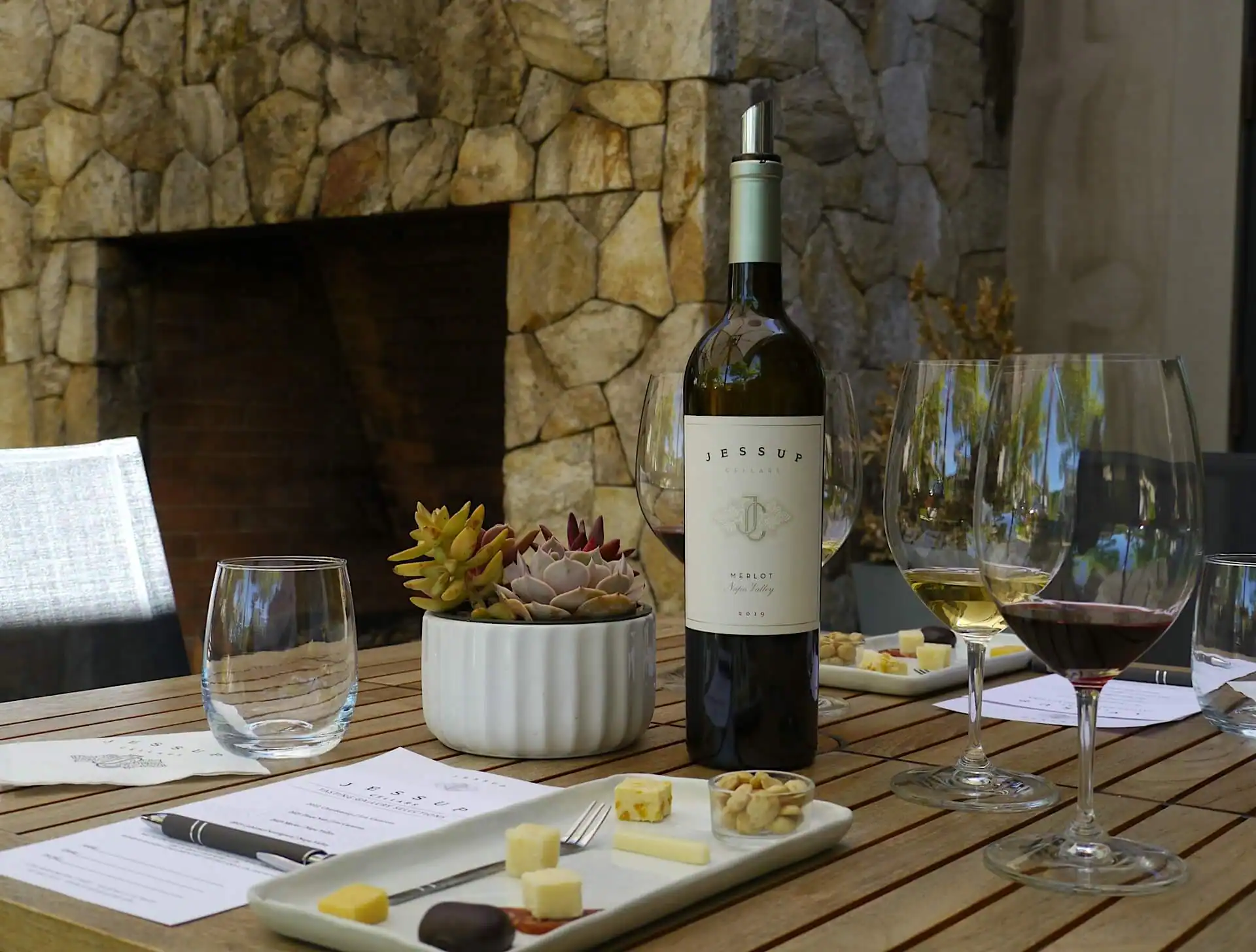The wine aging process transforms ordinary grape juice into the complex, nuanced wines we savor today. Whether you’re exploring Yountville’s tasting rooms or building your personal cellar, understanding how wine evolves over time deepens your appreciation for every bottle.
At Jessup Cellars in Napa Valley, we witness this transformation daily. Napa Valley’s Mediterranean climate, with warm days and cool nights, creates ideal conditions for wines with exceptional aging potential. Our ultra-premium wines showcase the artistry that happens when time, science, and craftsmanship unite with this remarkable terroir.
What is Wine Aging?
What is wine aging encompasses the complex chemical processes that occur after bottling. Think of it like a slow-simmered stew—the longer it cooks, the more flavors blend and develop. Unlike many beverages that deteriorate, wine continues evolving through carefully controlled chemical reactions.
Wine aging occurs in two phases. Primary aging happens in tanks or barrels before bottling. Secondary aging occurs after bottling when wines mature in controlled environments, developing the complexity that distinguishes great wines.
During bottle aging, wine undergoes slow oxidation despite being sealed. Tiny amounts of oxygen interact with wine components through the cork, creating gradual changes. This process requires patience—the chemistry of wine aging unfolds over months, years, or decades.
Napa Valley’s unique climate contributes to exceptional aging potential. Warm, dry summers allow grapes to develop concentrated flavors and robust structures, while cool evenings preserve crucial acidity levels.
Aged Wine Color Changes
Aged wine color provides visual evidence of transformation inside the bottle. Think of autumn leaves changing—color shifts tell the story of what’s happening inside.
Red wines begin with vibrant purple hues from anthocyanins—the same pigments that make blueberries blue. As wine ages, these molecules bind with tannins, creating larger structures. The color shifts from bright purple to deep ruby, then brick red, and finally amber in very old wines.
White wines start with pale yellow or green tints, like fresh apple slices. With age, they develop deeper golden hues as phenolic compounds oxidize. The most prized aged whites achieve beautiful amber colors.
These changes signal more than visual appeal—they indicate readiness to drink. A well-aged Napa Valley Cabernet showing brick tones suggests full complexity development.
Understanding color changes helps wine enthusiasts assess their bottles without opening them. The rim of the wine, viewed through the bottle or in a glass, reveals the wine’s evolution stage and drinking potential.
Science of Wine
The science of wine reveals how molecular interactions create flavors and aromas. Imagine wine as a symphony orchestra—hundreds of “musicians” (chemical compounds) must work together harmoniously.
Organic acids like tartaric and malic acid provide wine’s backbone. These create the crisp sensation that balances sweetness and alcohol while acting as natural preservatives during aging.
Alcohol serves as both preservative and messenger, carrying aromatic compounds to your nose. Picture alcohol as a delivery system that helps you smell those wonderful scents when swirling wine.
Sulfur compounds protect wine from harmful oxidation while allowing beneficial changes. These work like antioxidants, binding with oxygen to prevent off-flavors while preserving fruit characteristics.
Napa Valley’s volcanic soils and diverse microclimates contribute mineral compounds that enhance aging potential. Well-draining soils force vine roots deep, concentrating flavors and creating structural backbone for graceful aging.
Tannins in Wine Structure
Tannins in wine provide structure and aging potential, particularly in reds. If you’ve bitten into an unripe persimmon, you’ve experienced tannins—they create that dry, puckering sensation.
Young tannins feel harsh and astringent, overwhelming other flavors. As wine ages, tannins undergo polymerization—imagine paper clips linking together. This softens texture while maintaining structure.
Tannin levels vary between grape varieties. Cabernet Sauvignon contains high levels requiring years of aging, while Pinot Noir has lower levels, making it approachable young.
Napa Valley’s warm climate helps grapes develop ripe, supple tannins that integrate beautifully with age. Skilled winemakers at Jessup Cellars balance these elements for optimal aging potential.
Well-integrated tannins signal a wine’s maturity. When tannins no longer dominate the palate but instead support the wine’s fruit and aromatic complexity, the wine has achieved its intended character.
Esters in Wine Development
Esters in wine create the fruity and floral aromas that make wine appealing. Think of esters as nature’s perfume—compounds responsible for delightful scents wafting from your glass.
Primary esters develop during fermentation as yeasts convert sugars into alcohol. These create fresh fruit aromas—apple notes in Chardonnay or cherry in Pinot Noir.
Secondary esters form during aging as compounds interact. These create complex aromas like honey, nuts, or dried fruits. The process requires time and proper storage conditions.
Napa Valley’s temperature variations—warm days followed by cool nights—help grapes develop balanced ester profiles that continue evolving beautifully during bottle aging.
Phenolic Compounds in Wine
Phenolic compounds in wine encompass molecules that contribute color, flavor, and aging potential. These compounds, extracted from grape skins and seeds, undergo continuous transformation throughout wine’s life.
Anthocyanins provide red wine color, while flavonoids contribute to both color and flavor. These interact with tannins to create the wine’s overall sensory profile.
The balance of phenolic compounds determines aging trajectory. Wines with high phenolic content, like those from Napa Valley’s renowned terroir, develop extraordinary complexity over time, revealing new layers with each passing year.
Wine Cellar Temperature Impact
Wine cellar temperature dramatically influences aging and development. Think of temperature as the conductor controlling how fast chemical reactions happen.
The ideal range sits between 50-60°F (10-15°C), allowing beneficial reactions to proceed slowly. Consistency matters more than exact temperature—fluctuations cause wine to expand and contract, potentially compromising cork seals.
High temperatures above 70°F develop cooked flavors and destroy fresh characteristics. Low temperatures slow aging to a crawl, preventing wines from reaching full potential.
Ideal wine cellar conditions include stable temperature, proper humidity (50-70%), light protection, and minimal vibration. Napa Valley’s natural underground caves provide these conditions, which is why many wineries use them for aging.
Professional storage facilities maintain these conditions consistently, making them worthwhile investments for serious collectors. Home cellars can achieve similar results with proper insulation and climate control systems.
Which Wines Should Be Aged
Which wines should be aged depends on structure, variety, and winemaking style. Not all wines are meant to age—some are like fresh flowers for immediate enjoyment, while others become more valuable over time.
Red wines with high tannins, good acidity, and sufficient fruit concentration age beautifully. Cabernet Sauvignon, Merlot, and Bordeaux blends can improve for decades. These need time for tannins to soften and flavors to integrate.
White wines with high acidity also age well. Chardonnay and Riesling can develop extraordinary complexity over time.
Vintage matters significantly. Exceptional years like Napa Valley’s 2013, 2016, and 2018 produce wines with concentration and balance needed for long aging.
How old should wine be depends on these factors. Most reds benefit from 2-5 years aging, while exceptional bottles improve for 10-20 years. Whites typically peak within 2-7 years.
Wine Texture Changes with Aging
Wine texture undergoes remarkable transformation during aging, creating the silky mouthfeel that characterizes great mature wines. Think of the difference between rough cotton and fine silk.
Young wines often feel harsh or disjointed, with tannins, acidity, and alcohol competing for attention. As wine ages, these elements integrate and balance, creating harmonious texture.
Tannin polymerization softens astringency while maintaining structure. The harsh grip evolves into smooth, velvety texture that supports other characteristics.
Acid integration creates roundness and balance. Sharp edges soften into seamless profiles, like how sharp cheddar mellows into creamy aged cheese.
Alcohol integration creates warmth rather than burn. Napa Valley’s high-alcohol wines particularly benefit from this integration over time.
Creating Your Wine Aging Journey
Understanding the wine aging process enhances every aspect of wine appreciation. Whether building a cellar or selecting wines for special occasions, this knowledge helps you make informed decisions.
At Jessup Cellars, our commitment to crafting age-worthy wines reflects our understanding of these processes. Our ultra-premium wines reward patience, developing complexity that justifies careful cellaring.
Wine aging represents the intersection of science and art, where chemistry meets craftsmanship. The next time you uncork an aged bottle, you’ll appreciate not just its flavors but the remarkable journey it took to reach your glass.
For those interested in exploring age-worthy wines, visit our Yountville tasting room. Our staff can help you select wines that reward aging and provide cellaring guidance.
The world of wine aging offers endless discoveries. Each bottle tells a story of time, patience, and transformation. Ready to explore wines designed for aging? Contact us to learn about our current releases and discover how proper aging can transform your wine experience.

